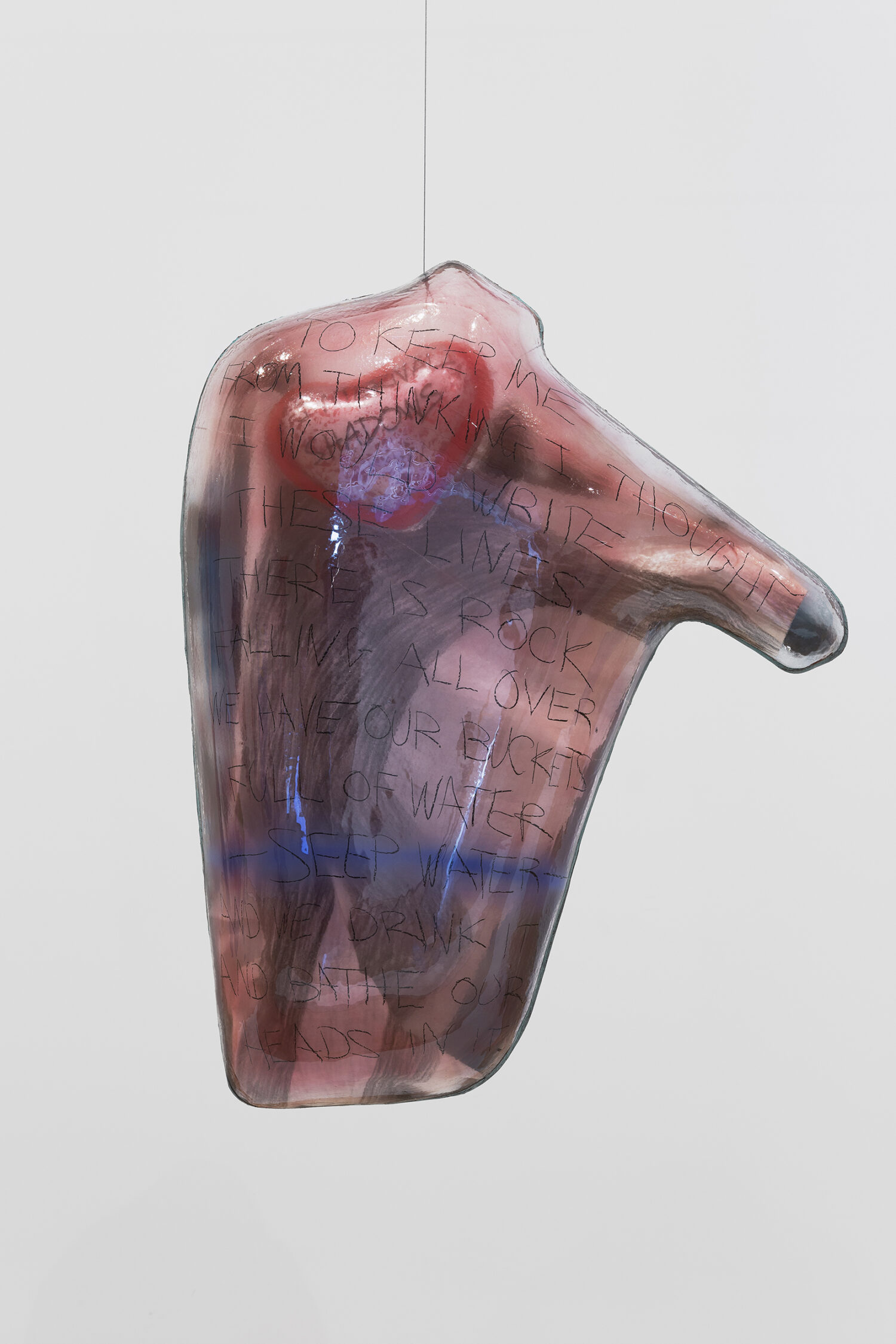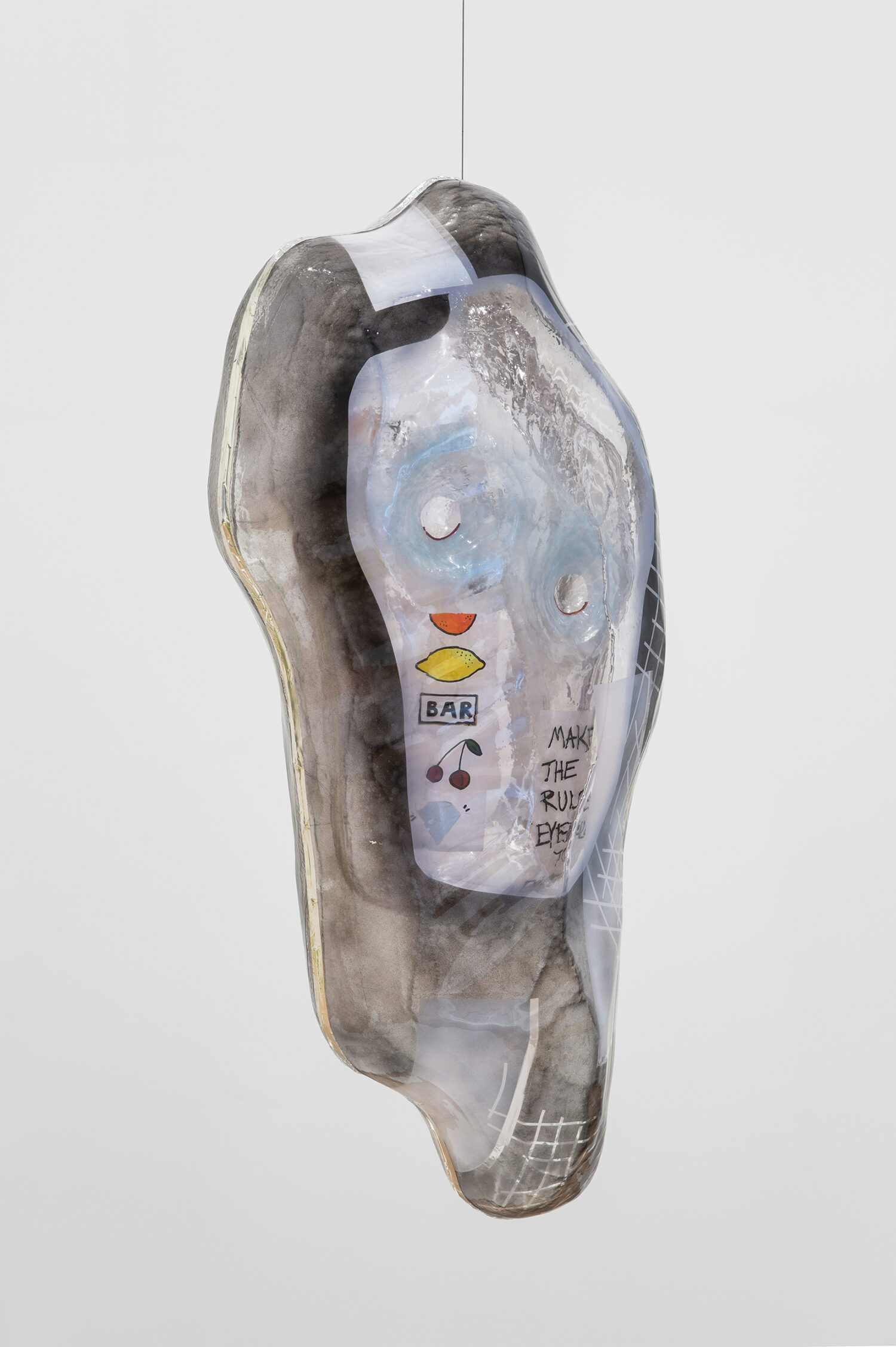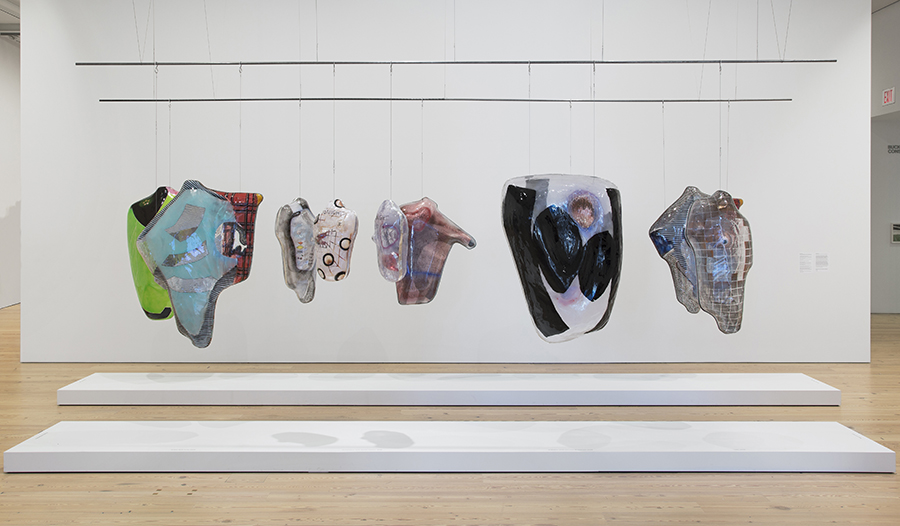
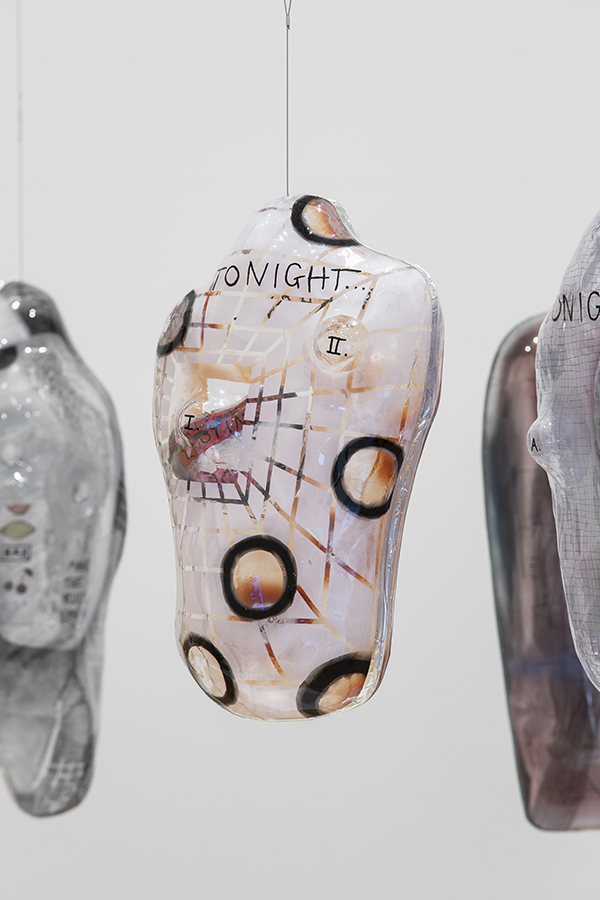
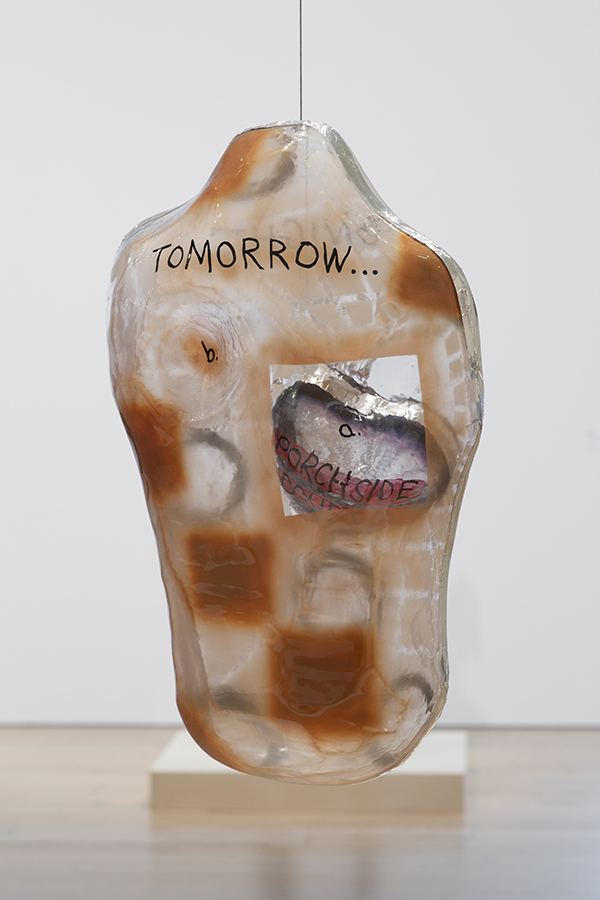

Spatial Language: A Conversation with Ragen Moss published in Sculpture Magazine
by Jan Garden Castro
Ragen Moss’s breakout success at the 2019 Whitney Biennial and her current solo show point to new directions in sculpture. Spatial and temporal foci, interiority, and embedded paradoxes and ironies push her investigations into the workings of relational, mental, and physical inner spaces. Her multi-layered sculptures draw on and intermix philosophy, poetry, politics, painting, art history, and contemporary culture. Instead of offering a statement, her works form puzzles and conundrums that hide inside seductive surfaces.
Jan Garden Castro: You’ve said that you want to “reinvigorate the history of sculpture away from surface and toward spatiality, mass, volume, and density.” That’s a huge objective. How did you come up with that, and how does your work put it into practice?
Ragen Moss: Some latent operations within sculpture’s discourse, such as space, haven’t been fully mined yet. I start from the idea of space. Much contemporary work has been interested in sculpture’s ability to narrate a story, offer a joke or pun, or challenge the differential between a non-art object versus an art object. I am interested instead in sculpture as the medium that can teach us what space is and why space is important. I come at this because I see each of us as being an awkward, bumbling biological body that is also inscribed by language. This friction between being a physical spatial being and also a thinking, relational spatial being is what generates my work. This, of course, is a political concept as well.
One thing I like to talk about that helps people understand my work is the idea that I can visualize your heart beating contemporaneously with but at a different tempo than my heart. More is going on between us than sculpture has traditionally and recently approached. My work tries to get people to consider that which is inward at a conceptual level, and also literally to look inward. In the works, sculptures and texts are embedded inside each other—there are layers. Each sculpture is transparent but operates in the round; each work is also inscribed by language and carries with it a demand that viewership be through-looking toward interior parts and ideas, and not just surface-looking.


JGC: Could you discuss one of your favorites pieces?
RM: Maybe I can talk about two pieces in relationship to one another. In addition to using sculpture as a medium that can think about and best address space, I am also interested in posing myself hard questions that help motivate me to make work. For the Whitney Biennial, I asked myself a temporal question: Can sculpture, even though it is, seemingly, oppositional to time, also speak about time? Two works in particular are generated from this challenge—even if this isn’t the most obvious thing about them: Romanettes (with double Hearts) and Driver (with Passenger (with Heart)), November.
Romanettes consists of two torso sculptures that each have a smaller, heart-shaped sculpture embedded inside them to make a total of four separate sculptures in one work. Romanettes deals with time in a Circadian way. The text on the outside front of each torso says, “Tonight…”; the back says, “Tomorrow…” This basic linguistic device of “Tonight…Tomorrow, Tonight… Tomorrow” comes from a poem, and it became a structuring tool for me to build the sculpture. What we do in the time-space between each “Tonight…” and each “Tomorrow…” ends up forming our lives, our humanity. What do you do between that sunrise and that sunset each day?
The inner heart-shaped sculptures of Romanettes also have text, so reading the full work across and inside says: “Tonight…Legislative Looting, Tomorrow… Porchside Bourbon,” and, “Tonight…Accounting Acrobatics, Tomorrow…Hotcakes!” The questions are basic but hard: How do you do a sour thing, go to sleep, and wake up the next day and simply have breakfast? How do you do a wrong thing, go home, and have a drink on your porch and relax?
Driver (with Passenger (with Heart)), November also had a time-based question to it, but not a Circadian-based concern as with Romanettes. This time, I challenged myself to use sculpture—which is, again, not usually thought of as a temporal medium—to address a predictive concept of time. In Driver, the middle sculpture has text on it that says, “Predictive economic model: market crash, Summer 2019.” The work makes a real-world prediction about our economic lives. The date I closed this sculpture was November 2018, and the biennial ran through September 2019, so I couldn’t mess with or change the work’s prediction—it operated the way that market operators operate—predictively. I liked the idea that during the course of the biennial, the work would either be miraculously right, or wrong like so many predictions. I didn’t mind which way it turned out.
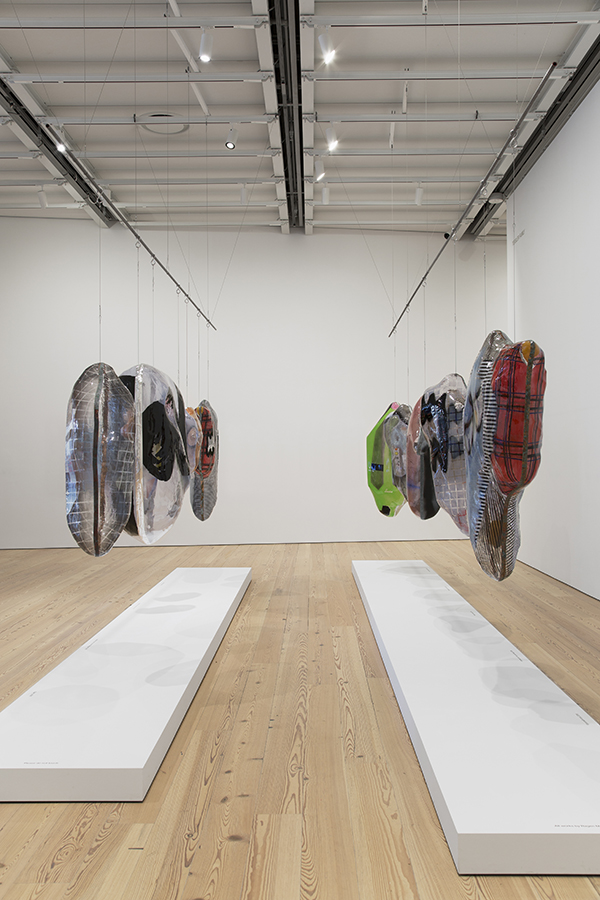
JGC: In today’s world, space is literally threatened. Does your work respond to that threat?
RM: I’m a subtle worker. The work comes off as alluring, but if you spend time with it, something should unfold. I spend my time researching before I start making anything. I enjoy reading about sociological, geographical, and philosophical views of space. I’ve spent a long time thinking about, speaking about, and writing about what space means. Obviously, dialogues about globalization raise a definite spatial question, but I don’t think my work lies there.
Instead, my interest is inward-looking. For important reasons, we need to remember that we’re not just the surfaces that we present to the world. There are spatial relations. I am a fan of Henri Lefebvre’s writing on the production of space; Doreen Massey is another resource. From them, I’ve learned to think about space differently—not just as a literal physical space, which is obviously a concern in my work, but also as mental and relational space, what it means to have a relationship that forms space.
I think of space as built—and that’s part of why the works have windowing in them. I want the works to suck in the room, suck in people, and push you back out, like a set of lungs. Space is built because it is in flux, relational, contingent, changing. And my work should have this quality about it. In part, this means that the works are best dealt with in “noisy” spaces— spaces that have a lot going on in them—not in a pristine white cube. I like my work in my messy studio and when it’s lived with in people’s homes, whatever they may look like. The works are meant to be generous in that they will suck in and exhale what’s around them. I think that’s our experience of the world as well.
JGC: Unlike many artists, you have your studio at home and you fabricate everything yourself. How does that work?
RM: I have more ideas than I can build, which is always exciting. I love making this work. Each piece is an opportunity to make the next one. They’re all attached. I have a studio and a workshop at home in Los Angeles. I can make more work that way, and it doesn’t feel compartmentalized from my life. I can set up technical processes that my work requires, wash up, come inside, take care of something else, go back. I don’t have to put walls around my practice. I am almost constantly working….
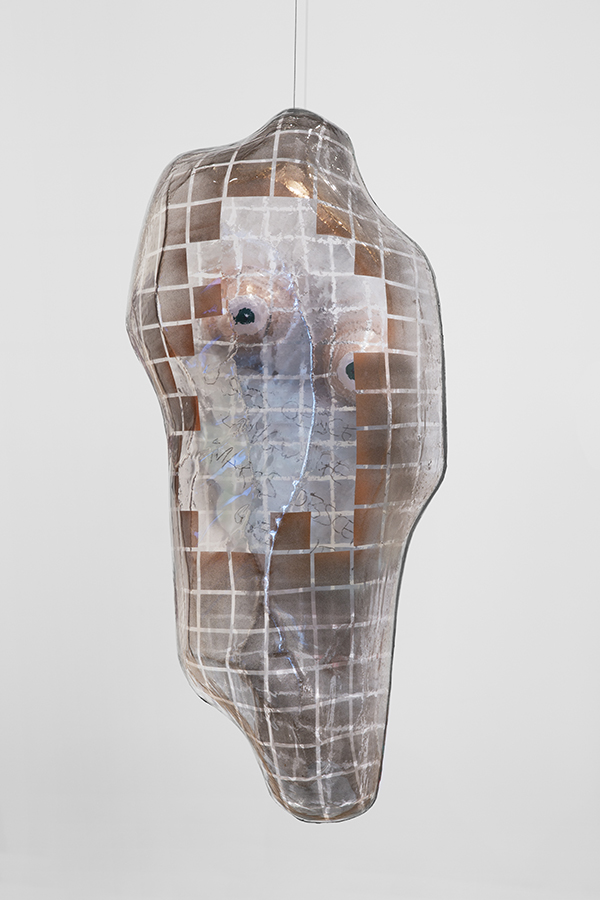
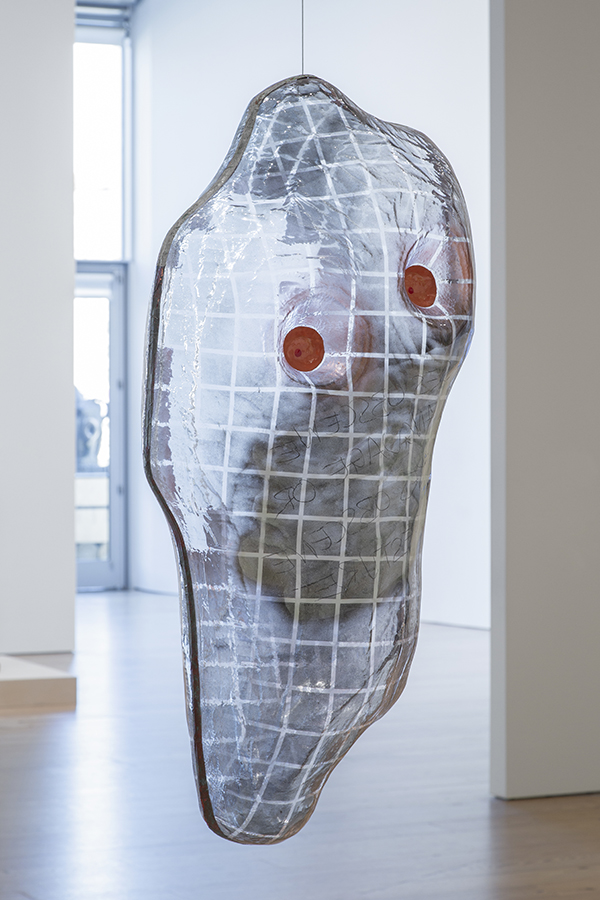
JGC: You’ve said that your materials aren’t as important as the process.
RM: Right. I tend not to want to talk about the name of the thing I’m making things out of. I’m not a materialist. Some excellent makers are very invested in the symbolism of a material or its properties—its texture, its provenance, its entry or exit from the stream of commerce, or its relationship to industrialized production. Materials are not signifiers for me in that way. Working in a transparent medium is what I’m after.
JGC: How does being a mother add to your practice?
RM: To be more precise with language, I’ll speak of myself as a parent more than as a mother. I’m a parent with a very strong co-parent, and this makes everything not just possible, but also energizing. Being a parent reminds me on more than a daily basis about what’s important. I believe in art and in its ability to lessen our sense of disjunction in the world, but being responsible for another human’s flourishing is the most important thing.
JGC: You were born in New York and are now in Los Angeles. Has the move influenced your work and life?
RM: I have the pace, gait, and speech of a New Yorker. I am fast, voracious, and direct like a New Yorker, but it is good to live in a place with larger studios, and sunshine is very good for me. I am a swimmer; there is nothing like submerging myself in an outdoor body of water—I make work (mentally) while I’m swimming.
JGC: I’m unsure whether or not you identify with Paul Thek, but the Whitney Biennial catalogue essay thinks you do. What about some of the West Coast artists?
RM: I think I could get lumped in with some Light and Space artists, but my inputs are so wide ranging that it’d be hard to find a clear thread. Being mentioned in the same sentence as Paul Thek is great. I think decomposition is weird and good, but I don’t think my work looks decomposed. And although there is a meat-hanging reference, I hang my work more because I care about motion and time being involved in sculpture. When hung, the works have a slight reactivity to people’s currents as they pass by. Also, I have yet to figure out a way to address the concept of a pedestal. I’m working on it, though; I think the pedestal is a good challenge. Hanging work off the floor is a concise way to get a nice shadow, a nice set of movements, to imbue a work with time, and for now to avoid the Modernist question of a pedestal.
In terms of people I identify with, it would not be for resemblance or visual impact alone; when I think of influences, I think of what operations are relevant to me. Along these lines, there are playful painting references. Lee Bontecou is a good reference. I studied with Mary Kelly, and what I have from Mary, if you look, is text and editing. I would put El Lissitzky in the room with me. His Prouns have early meaning for me. Tomas Tranströmer is maybe the poet that I go back to—he’s basically a sculptor creating space through language. Glenn Ligon is a reference; I can learn from his ways of using text. I like all of these makers’ works, but I don’t make their work—I don’t make work that looks like their work—I make my work.
